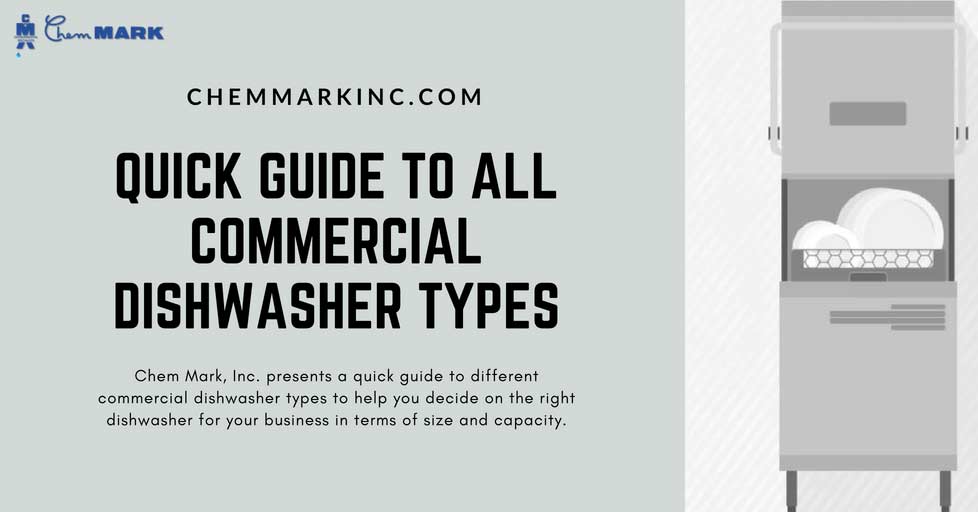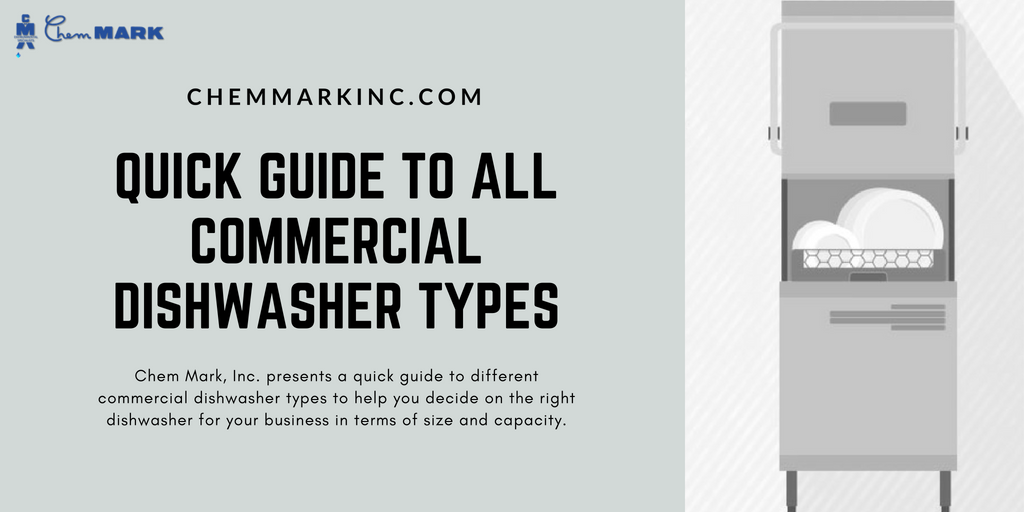Commercial Dishwasher Types Explained

The commercial dishwasher is the backbone of any business in the commercial foodservice industry, as it will influence the number of people a restaurant or any other establishment can serve. Since clean dishes are an imperative for any such business, you’ll have to be very careful with balancing your budget and choosing a dishwasher that is capable of keeping up with the demand.
Although commercial dishwashers are designed to get dishes cleaned much more quickly than the residential dishwashers, there are differences among different types, primarily in terms of their size and capacity. It is crucial to take the size of your business and the periods with highest traffic into consideration when choosing the right dishwasher type.
Precisely this will be the purpose of this article – to present different commercial dishwasher types that are available and to help you decide on the right dishwasher for your business in terms of size and capacity.

Commercial Glass Washer
Since glasses are much more fragile than other types of washware, commercial kitchens, clubs, pubs and other establishments that deal with a high volume of glassware can benefit from a machine that combines the power of a commercial dishwasher and a gentle water flow that won’t break or damage even the most sensitive types of glassware (e.g. martini or wine glasses).
Although there are certain models that are suitable for washing both glassware and other types washware, it is generally recommended that the glass washers are used specifically for washing glasses. Namely, glass washers use lower temperatures than dishwashers and they have unique setup of detergent and rinse aid that is specifically suited for washing glassware.
Maximum dimensions of glass washers are 72″ wide, 22″ deep and 38″ high. They usually come as undercounter models with prices that match the prices of undercounter dishwashers. However, there are different styles of glasswashers as well, and they usually cost more.
Most commercial glass washers use wire racks or bar storage racks, while larger machines use plastic 20″x20″ racks that have dividers and heightening frames and are designed to reduce breakage. These machines have quick cycle times and can wash from between 750 to 1,000 to as much as 2,000 glasses per hour.
Besides gentle washing action there will be certain establishments that will find machine’s noise levels quite important. Businesses that keep the glass washer behind the counter will need to pay more attention to this factor, as the machine will be placed so closely to the customers.
Main features of commercial glass washers:
- Designed to wash the most sensitive types of glassware without damage
- Designed to wash a great number of glasses quickly
- Can wash other warewash types such as dishes and utensils
- Ideal for bars, pubs, clubs, dinners, coffee shops and restaurants with high turnover of glassware
Commercial Undercounter Dishwasher
Commercial grade undercounter dishwashers are quite like residential dishwashers when it comes to their size and appearance, washing a single rack per cycle. The difference is in speed and capacity, as commercial grade undercounter dishwashers have incomparably faster cycles and hold more dishes.
The minimum total cycle time is 2 minutes, but some models also have an option to choose longer cycles when washing cutlery and more heavily soiled items. On average, the capacity of an undercounter dish machine is 30-35 racks or about 750 dishes per hour. Most models use 20″x20″ plastic racks, but there are also certain more compact models that use smaller racks.
The undercounter dish machine has spinning upper and lower rotating washing arms that spray water and cleaning detergents through the nozzles. The wash and final rinse principle are same as with glass washers except these models use more powerful pumps.
Due to their capacity and size that usually doesn’t exceed the width of 23″ wide, 25″ deep and 53″ high, undercounter dish machines are the best choice for coffee shops, smaller diners or restaurants, bars and small nursing homes, as they face limited space and don’t see a lot of traffic. Ideal for establishments serving not more than 100 meals per hour.
Main features of undercounter dishwashers:
- Don’t require a lot of space
- Allow counter space on top
- Easy to install
- Most affordable type of commercial dishwashers
- Must be plumbed into the main water supply
- Needs to have access to a waste drain
- Usually comes with a standard 3-pin plug attachment
- Ideal for smaller establishments serving up to 100 meals per hour
Hood Dishwasher
Hood-type, door-type or pass-through dishwashers have a larger capacity than the undercounter type – these machines can process anywhere between 40 and 175 racks per hour depending on the model and the type. There are door-type dishwashers with a single and double-rack washing compartment and the wash cycle can go under a minute.
While they don’t have a significantly larger foot print (typically, around 26″ wide and 25″ deep) they are much taller – usually around 92″, so the height is a factor to be taken into consideration when planning the kitchen space.
Older models usually have side doors while the newer models have a hood that is opened manually or automatically to easily slide the racks of dishes in and out. The racks can be pushed inside either from the side (corner commercial dishwasher) or straight in (straight models). Corner models are helpful if facing space limitations. Placing them in corners will help you get the most out of available space.
These machines have numerous advantages over the undercounter models. The most obvious one is easier and faster loading, since it is performed at bench height. There is no bending over, kneeling or lifting, simply sliding the racks in. Another advantage is that the racks can be loaded while the machine is in process. The clean rack gets pushed out as the rack with dirty dishes enters the wash chamber.
With this clear separation between clean and soiled dishware hygiene is significantly improved as well. Productivity can be further improved by setting up a pre-rinse sink with an overhead spray nozzle to rinse the dishes before they enter the machine. Dishtables can further be connected to form a streamlined assembly line action of pre-rinse, wash and dry.
In most situations commercial dishwashers with a certain power rating require an exhaust hood. Modern technology enabled the use of steam condensers that eliminate the need for separate extraction hoods. The principle is as follows: the hot air created during the final rinse passes through a heat exchanger that cools it down and condense it with cold water that is in turn pre-heated for the final rinse.
Main features of door-type dishwashers:
- High capacity dishwasher
- Fast and easy loading
- High washing speed
- Must be plumbed into the main water supply
- Needs to have access to a waste drain
- Requires hardwiring by an electrician
- Used by most restaurants and establishments that serve between 100-500 meals per hour
Commercial Conveyor Dishwasher
Conveyors are true monsters of dish machines. They are the largest in size (upright conveyors can be 4′ – 7′ wide and 10′ high) and capacity and are therefore, used for largest establishments such as schools, universities, hospitals, prisons and hotels or any other industrial kitchens that can and need to process over 200 racks per hour or about 5400 dishes.
Besides the capacity, another advantage is speed. Since multiple tanks can be placed in a row (e.g. pre-wash tank, wash tank, final rinse tank), no time is wasted on opening and closing the hood or manually pre-rinsing the dishware. Dishes are simply loaded into a rack and carried through various cleaning stages until they come out clean on the other side.
Main features of conveyor dishwashers:
- Fast washing cycles
- Powerful cleaning
- Designed to clean large quantities of washware
- Designed to clean largest pieces of washware
- Requires a suitable plumbing connection to the mains water supply
- Must be placed near a waste drain
- Requires a 3-phase electrical connection
- Requires hardwiring by an electrician
Utensil Washers
In case you are ready to invest money in specialized dishwashing machines that have a more powerful wash pattern for heavy wash items and a larger wash chamber, you can get a machine specifically designed for washing pots, pans, mixing bowls and utensils.
These types of dishwashers are a subset of the door-type dishwashers that eliminate the need for presoaking or scrubbing scour pots and pans while removing even the most stubborn soils.
They come in various sizes, so you can choose the most appropriate one depending on the size of your operation. For example, there are utensil washers designed to clean a high volume and a wide range of utensils which makes them ideal for large commercial kitchens, hotels and schools that need to wash a wide variety or large utensils and cooking items.
There are also pot and pan washers, specifically designed to wash large pots and pans (e.g. gastronorm containers), bread pans and tin straps commonly used in bakeries and other commercial food production establishments. On the other hand, tray washers are designed to stack and wash multiple trays, which makes them ideal for schools, universities and food production establishments that need to wash baking trays and sheets.
Commercial Countertop Dishwasher
As the name suggests, these units are mounted on top of the counters and are therefore an ideal choice for commercial kitchens with limited space, such as small coffee shops, mobile food trucks, ice cream trucks, office kitchens, food courts, even daycare center and smaller schools.
The capacity of countertop dishwashers is about 20 racks or 120 average dishes per hour.
Important Facts to Consider When Sizing the Commercial Dishwasher
- Approximately 35 racks of dirty dishes are generated for every 100 meals. However, this is not a strict rule and it will vary depending on the type of restaurant or establishment, the number of dishes used by each guest on average and the number of times a table is turned during a single day.
- The size and capacity of the right dishwasher will be determined by the busiest times of day, days of week or busiest months during a year. In case you think about the average daily traffic without considering, for example, happy hour time or Saturday evenings, you’re up for a disaster during your busiest times as the dishwasher won’t be able to keep up with the high demand.
- Include the expected growth of your business when making the calculation by adding about 10-20% of extra capacity. This is especially important when making a purchase, as you’ll want your dishwasher to keep up the pace with the growth of your business during its entire life span (usually 5-10 years if properly maintaining the dishwasher)
- Consider your entire warewash inventory, not just the dishware or glassware that is served to customers. Cookware and other washware used by your employees also need to be washed, let your largest pots and pans be a place to start sizing.
Need detailed tips on how to choose the best commercial dishwasher for your business? Talk to a specialist today! (714) 784-5522 or fill out our contact form
